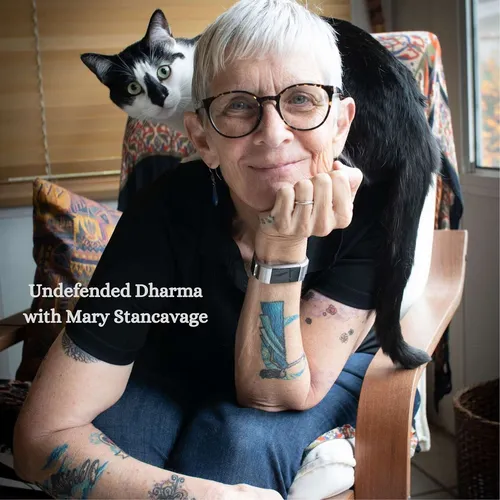
Undefended Dharma with Mary Stancavage
Dharma talks from meditation teacher Mary Stancavage. These focus primarily on the pragmatic aspects of Buddhist teachings and philosophy drawing strongly on wisdom and heart practices. All are viewed through the lens of learning to live with an Undefended Heart. (photo by @kimanhuynh)
- Update frequency
- every 7 days
- Average duration
- 28 minutes
- Episodes
- 343
- Years Active
- 2018 - 2025

A Brave New World - Or Is It?
As the pandemic restrictions ease we are either looking for a return to normalcy or expecting a new way of life. Each of these ideas indicates an arrival and an attachment to the way it's supposed to…

Insidious Delusion
Delusion, not seeing clearly, is something we find everywhere, both in our personal lives and at the collective and national level. Sometimes it is recognizable, but often it's subtle and we don't ev…

Making It Safe for Everyone
The ease with which humans create identities around self and other makes it challenging to recognize our shared humanity and live in harmony. Listening to the news on any day will prove this point. T…

Distortions of the Mind
The Buddha was very clear in talking about how we allow small misperceptions to blossom into full blown delusions which cause harm to ourselves and others and continue the cycle of suffering. In this…

We're All Human
Sometimes our humanity just smacks us right in the face and there is no getting around the fact that life can be messy and there are no secret ways out of feeling. The world continues to rage and dan…

Practice: Just Like Riding a Bicycle
Energy or effort is an important part of the path to awakening. Our practice is not simply sitting back and waiting for something to happen; instead we bring a wise energy and effort to guide the hea…

Diving into the Satipaṭṭhāna
The Satipaṭṭhāna Sutta is called the direct path to realization, or in other words, the path to awakening. These important instructions are all about developing our mindfulness practice and cultivati…

Relaxed and Aware
Mindfulness is not about striving or getting things done. Instead, the practice is about a relaxed receptivity which allows a more spacious and embodied awareness. In this talk Mary discusses how to …

Be a Bodhisattva
The idea of a Bodhisattva runs throughout Buddhist scriptures and tradition. It means "destined for Buddhahood" and also means one who is dedicated to the spiritual path. It is especially powerful wh…

The Power of the Pause
To pause is such a little thing, a breath, a count to ten, yet it can mean a world of difference. We're so wound up in our habits, reactions and even being productive, that pausing is a challenging p…

The Path to Enlightenment
In several suttas the Buddha mentions the 37 qualities needed to move toward freedom and enlightenment. In this talk Mary discusses these qualities and important ethical living and mindfulness are to…

Blame and Shame
Blame and shame are two items we're all pretty familiar with these days - they seem to be everywhere. What did the Buddha have to say about them, if anything, and how do we let go? Mary discusses the…

Dharma Everywhere
When your eyes and ears are open, the lessons of the dharma can be found everywhere. In this talk, Mary offers several examples, ranging from Bob Marley to Aristotle to James Baldwin, of how our pra…

Getting Unstuck
The Buddha talks about the fetters which are what bind us to Samsara and a cycle of suffering and discontent. There are three fetters, self-illusion, doubt, and attachment to rites and rituals that a…

Don't Miss the Joy
We're living through a time of continuing change and challenge. It's easy to become overwhelmed by it all which makes it doubly important to pause and be present for the joy that exists in all of our…

Making Peace with Our Demons
The wonderful story of Milarepa and his cave full of demons is emblematic of how we can move through the world and of our spiritual path. It's also a story of cultivating wisdom and learning how to b…

Holding Ourselves Dear
In the Rajan Sutta (Ud 5.1), the Buddha invites us to acknowledge that just as we find no one dearer than ourselves, we should recognize that others feel the same and so we should not hurt others if …

Reclaiming the Heart, Reclaiming the Sacred
For our entire lives we have been told who to be, how to behave and what to believe. This conditioning sets us up for suffering and being disconnected from our hearts and the sacred. Reconnection beg…

A New Beginning
We spend a lot of time attaching importance to particular dates or moments believing that our lives or circumstances will change when something finally happens. This leads to a sense of striving both…

Being Fully Present
In order to be fully present and open we have to learn to be receptive rather than reactive. Because of our conditioning we're not aware of how reactive and stuck in habits we can be. Mary talks abou…